Your local hardware store may rent you an SDS drill for the day if you don't need one day to day
DIY
For DIY - this is also a placeholder.
Another option is to mount a junction box (like this) outside. Just run the ethernet cable through the wall, instead of the camera's pigtail. This is a more future-proof method as you can change cameras without disrurbing the sealed wall penetration.
That's a good call. I wasn't sure on the cable seals and fitting all the wire through it and still being snug on the small cable.
For a similar project, I got this doofy hole saw set from Harbor Freight:
https://www.harborfreight.com/1-14-in-3-14-in-carbide-grit-hole-saw-assorted-set-9-piece-57708.html
I was able to knock a hole large enough to shove a piece of 1-1/2" PVC conduit through a foundation wall without much trouble, using a regular (non-hammer) drill. It took about five minutes, no sweat. Although obviously I had to come at it from both sides. I later did the same to put a length of flexible conduit through to power my mini-split outdoor unit.
If I were you I'd use the smallest saw in that and then use one of these conduit junction dinguses on the outside to house the plugs and ensure they remain dry -- and enable you to access them if you ever need to fuck with it later.
Not sure which model this is, if it is the poe version, you only need to connect the ethernet cable, it will also power the camera.
That's what I'm doing, but the lot of it still needs to feed through. And the biggest bit is the rj45 bit anyway
This is a mistake. Get another camera you just need to attach to wall or one that takes micro USB for power.
Your library may have a borrowable SDS drill.
_ /\ _
There's a very easy way to detach the cable, it's called scissors. If it needs to be weather shielded on either side, some heatshrink flextube will get the job done.
If I need to solder anyway I would be unsoldering at the camera end. No cutting that way, no compromise to the cable. It is probably a pita though.
I think it all needs to go through as cutting at the splitter point wouldn't leave enough cable. And cutting the smaller connectors off doesn't really help
That's one way for sure. Downside is it more likely to result in mistakes and it's a tedious PITA (source: done it dozens of times). Doing at the camera end on the PCB introduces the possibility of breaking something taking it apart or putting it back together. Plus, that's a lot of wires to be messing with if one isn't experienced. But it is a cleaner way of doing it than cutting the cables in half.
I think a rented hammer drill is the right answer. Simple. No chance of screwing the electronics. Can easily fill the hole again, if needed.
